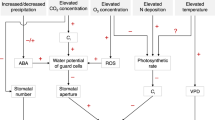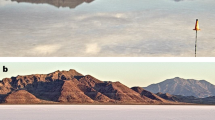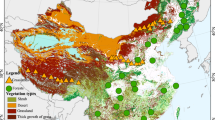Abstract
Stomatal conductance (gs) is a key land-surface attribute as it links transpiration, the dominant component of global land evapotranspiration, and photosynthesis, the driving force of the global carbon cycle. Despite the pivotal role of gs in predictions of global water and carbon cycle changes, a global-scale database and an associated globally applicable model of gs that allow predictions of stomatal behaviour are lacking. Here, we present a database of globally distributed gs obtained in the field for a wide range of plant functional types (PFTs) and biomes. We find that stomatal behaviour differs among PFTs according to their marginal carbon cost of water use, as predicted by the theory underpinning the optimal stomatal model1 and the leaf and wood economics spectrum2,3. We also demonstrate a global relationship with climate. These findings provide a robust theoretical framework for understanding and predicting the behaviour of gs across biomes and across PFTs that can be applied to regional, continental and global-scale modelling of ecosystem productivity, energy balance and ecohydrological processes in a future changing climate.
This is a preview of subscription content, access via your institution
Access options
Subscribe to this journal
Receive 12 print issues and online access
$209.00 per year
only $17.42 per issue
Buy this article
- Purchase on Springer Link
- Instant access to full article PDF
Prices may be subject to local taxes which are calculated during checkout



 and MI.
and MI.
Similar content being viewed by others
References
Cowan, I. R. & Farquhar, G. D. Stomatal function in relation to leaf metabolism and environment. Symp. Soc. Exp. Biol. 31, 471–505 (1977).
Chave, J. et al. Towards a worldwide wood economics spectrum. Ecol. Lett. 12, 351–366 (2009).
Wright, I. J., Falster, D. S., Pickup, M. & Westoby, M. Cross-species patterns in the coordination between leaf and stem traits, and their implications for plant hydraulics. Physiol. Plant. 127, 445–456 (2006).
Sitch, S. et al. Evaluation of ecosystem dynamics, plant geography and terrestrial carbon cycling in the LPJ dynamic global vegetation model. Glob. Change Biol. 9, 161–185 (2003).
Cao, M. & Woodward, F. I. Dynamic responses of terrestrial ecosystem carbon cycling to global climate change. Nature 393, 249–252 (1998).
Friedlingstein, P. et al. Climate–carbon cycle feedback analysis: Results from the C4MIP model intercomparison. J. Clim. 19, 3337–3353 (2006).
Schulze, E-D., Kelliher, F. M., Korner, C., Lloyd, J. & Leuning, R. Relationships among maximum stomatal conductance, ecosystem surface conductance, carbon assimilation rate, and plant nitrogen nutrition: A global ecology scaling exercise. Annu. Rev. Ecol. Syst. 25, 629–660 (1994).
Kowalczyk, E. A. et al. The CSIRO Atmosphere Biosphere Land Exchange (CABLE) Model for Use in Climate Models and as an Offline Model (CSIRO Marine and Atmospheric Research, 2006).
Leuning, R. A critical appraisal of a combined stomatal-photosynthesis model for C3 plants. Plant Cell Environ. 18, 339–355 (1995).
Oleson, K. W. et al. Technical Description of Version 4.0 of the Community Land Model (CLM) (NCAR, 2010).
Ball, J. T., Woodrow, I. E. & Berry, J. A. Progress in Photosynthesis Research (Martinus Nijhoff Publishers, 1987).
Kattge, J. et al. TRY—a global database of plant traits. Glob. Change Biol. 17, 2905–2935 (2011).
Lloyd, J. & Farquhar, G. 13C discrimination during CO2 assimilation by the terrestrial biosphere. Oecologia 99, 201–215 (1994).
Medlyn, B. E. et al. Reconciling the optimal and empirical approaches to modelling stomatal conductance. Glob. Change Biol. 17, 2134–2144 (2011).
Prentice, I. C., Dong, N., Gleason, S. M., Maire, V. & Wright, I. J. Balancing the costs of carbon gain and water transport: Testing a new theoretical framework for plant functional ecology. Ecol. Lett. 17, 82–91 (2014).
Héroult, A., Lin, Y-S., Bourne, A., Medlyn, B. E. & Ellsworth, D. S. Optimal stomatal conductance in relation to photosynthesis in climatically contrasting Eucalyptus species under drought. Plant Cell Environ. 36, 262–274 (2013).
Bernacchi, C. J., Singsaas, E. L., Pimentel, C., Portis, A. R. Jr & Long, S. P. Improved temperature response functions for models of Rubisco-limited photosynthesis. Plant Cell Environ. 24, 253–259 (2001).
Harrison, S. P. et al. Ecophysiological and bioclimatic foundations for a global plant functional classification. J. Veg. Sci. 21, 300–317 (2010).
Gotsch, S. et al. Allocation to leaf area and sapwood area affects water relations of co-occurring savanna and forest trees. Oecologia 163, 291–301 (2010).
Eamus, D., O’Grady, A. P. & Hutley, L. Dry season conditions determine wet season water use in the wet—tropical savannas of northern Australia. Tree Physiol. 20, 1219–1226 (2000).
Hacke, U. G., Sperry, J. S., Pockman, W. T., Davis, S. D. & McCulloh, K. A. Trends in wood density and structure are linked to prevention of xylem implosion by negative pressure. Oecologia 126, 457–461 (2001).
Meinzer, F. C., James, S. A., Goldstein, G. & Woodruff, D. Whole-tree water transport scales with sapwood capacitance in tropical forest canopy trees. Plant Cell Environ. 26, 1147–1155 (2003).
Bucci, S. J. et al. Functional convergence in hydraulic architecture and water relations of tropical savanna trees: From leaf to whole plant. Tree Physiol. 24, 891–899 (2004).
Sperry, J. S., Meinzer, F. C. & McCulloh, K. A. Safety and efficiency conflicts in hydraulic architecture: Scaling from tissues to trees. Plant Cell Environ. 31, 632–645 (2008).
Choat, B. et al. Global convergence in the vulnerability of forests to drought. Nature 491, 752–755 (2012).
New, M., Hulme, M. & Jones, P. Representing twentieth-century space–time climate variability. Part I: Development of a 1961–90 mean monthly terrestrial climatology. J. Clim. 12, 829–856 (1999).
Gallego-Sala, A. et al. Bioclimatic envelope model of climate change impacts on blanket peatland distribution in Great Britain. Clim. Res. 45, 151–162 (2010).
Gobron, N. et al. Evaluation of fraction of absorbed photosynthetically active radiation products for different canopy radiation transfer regimes: Methodology and results using Joint Research Center products derived from SeaWiFS against ground-based estimations. J. Geophys. Res. 111, D13110 (2006).
Zanne, A. E. et al. Data from: Towards a Worldwide Wood Economics Spectrum (Dryad Data Repository, 2009).
R Core Team, R: A language and Environment for Statistical Computing (R Foundation for Statistical Computing, 2014).
Pinheiro, J., Bates, D., DebRoy, S., Sarkar, D. & Team, R. C. nlme: Linear and Nonlinear Mixed Effects Models R Package Version 3.1-117 (R Foundation for Statistical Computing, 2014).
Breheny, P. & Burchett, W. Visreg: Visualization of Regression Models R Package Version 2.0-5 (R Foundation for Statistical Computing, 2014).
Acknowledgements
This research was supported by the Australian Research Council (ARC MIA Discovery Project 1433500-2012-14). A.R. was financially supported in part by The Next-Generation Ecosystem Experiments (NGEE-Arctic) project, which is supported by the Office of Biological and Environmental Research in the Department of Energy, Office of Science, and through the United States Department of Energy contract No. DE-AC02-98CH10886 to Brookhaven National Laboratory. M.O.d.B. acknowledges that the Brassica data were obtained within a research project financed by the Belgian Science Policy (OFFQ, contract number SD/AF/02) and coordinated by K. Vandermeiren at the Open-Top Chamber research facilities of CODA-CERVA (Tervuren, Belgium).
Author information
Authors and Affiliations
Contributions
Y-S.L., B.E.M. and R.A.D. conceived, designed and analysed the data and wrote the manuscript. I.C.P. contributed to study design and comments on the manuscript. R.A.D., B.E.M. and S.B. contributed to the implementation of the optimal stomatal model for C4 species in the Supplementary Note. H.W. wrote the R script for the implementation of the STASH model and commented on the manuscript. All other authors contributed data and commented on the manuscript.
Corresponding author
Ethics declarations
Competing interests
The authors declare no competing financial interests.
Supplementary information
Rights and permissions
About this article
Cite this article
Lin, YS., Medlyn, B., Duursma, R. et al. Optimal stomatal behaviour around the world. Nature Clim Change 5, 459–464 (2015). https://doi.org/10.1038/nclimate2550
Received:
Accepted:
Published:
Issue Date:
DOI: https://doi.org/10.1038/nclimate2550
This article is cited by
-
Marginal water use efficiencies of different plant functional types along an elevation gradient in subalpine regions
European Journal of Forest Research (2024)
-
A slow-fast trait continuum at the whole community level in relation to land-use intensification
Nature Communications (2024)
-
Rubisco deactivation and chloroplast electron transport rates co-limit photosynthesis above optimal leaf temperature in terrestrial plants
Nature Communications (2023)
-
Stomatal responses of terrestrial plants to global change
Nature Communications (2023)
-
Stomatal conductance models in Brazilian forest plantations: genotype and environmental effects on eucalypt and pine forests
New Forests (2023)



